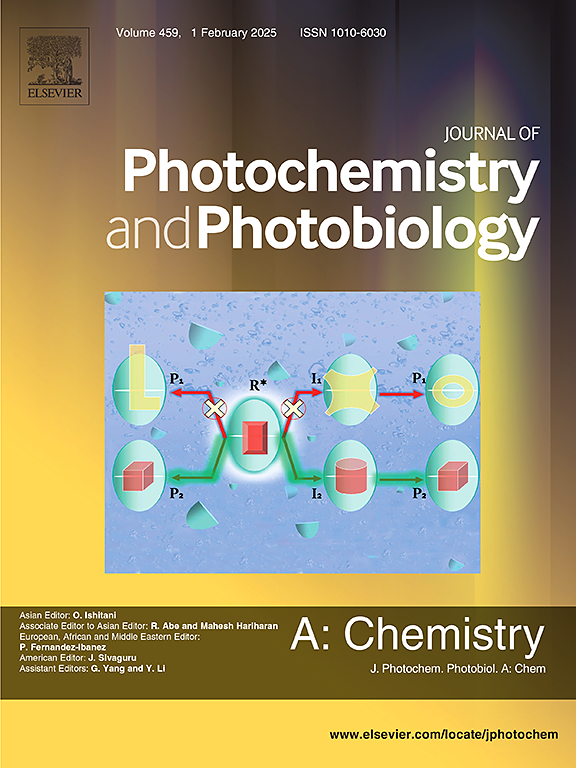Accelerated depolymerization of rice straw-derived lignin to vanillin and guaiacol using γ-Fe2O3/N, Fe-TiO2 as novel photocatalyst under visible light in aqueous media
IF 4.1
3区 化学
Q2 CHEMISTRY, PHYSICAL
Journal of Photochemistry and Photobiology A-chemistry
Pub Date : 2025-04-08
DOI:10.1016/j.jphotochem.2025.116440
引用次数: 0
Abstract
Vanillin and guaiacol, essential value-added chemicals widely utilized in the cosmetic and healthcare industries, have been sustainably derived from rice straw-derived lignin using a novel γ- Fe2O3/N, Fe-TiO2 photocatalyst under visible light irradiation. A green approach employing a deep eutectic solvent (DES) was used to induce a bandgap shift, facilitating the activation of the photocatalyst in the visible range. The structural, physicochemical, and optical properties of the synthesized photocatalyst were well-analyzed using various analytical techniques. The optimal conditions for achieving maximum lignin depolymerization of 97.1% and a high yield of vanillin and guaiacol were determined to be an initial lignin concentration of 50 mg/L, a catalyst loading of 0.7 g/L, the addition of 1 mL/L H2O2, and a pH of 5, with a reaction duration of 4h. The enhanced photocatalytic activity of γ- Fe2O3/N, Fe-TiO2, was attributed to its modified bandgap, enabling visible-light absorption and the generation of reactive oxygen species, as confirmed by scavenging studies. This study provides a significant contribution to the sustainable valorization of lignin from agricultural waste biomass, demonstrating the potential for the scalable production of vanillin and guaiacol under visible-light-driven photocatalysis.

以γ-Fe2O3/N、Fe-TiO2为新型光催化剂在可见光下加速稻草木质素解聚为香兰素和愈创木酚
香兰素和愈创木酚是广泛应用于化妆品和医疗保健行业的重要增值化学品,它们是在可见光照射下使用新型γ- Fe2O3/N, Fe-TiO2光催化剂从稻草来源的木质素中可持续地提取出来的。采用一种采用深共晶溶剂(DES)的绿色方法来诱导带隙移位,促进光催化剂在可见光范围内的激活。利用各种分析技术对合成的光催化剂的结构、物理化学和光学性质进行了分析。结果表明:木质素初始浓度为50 mg/L,催化剂用量为0.7 g/L, H2O2加入量为1 mL/L, pH为5,反应时间为4h,木质素解聚率为97.1%,香兰素和愈创木酚收率最高。γ- Fe2O3/N, Fe-TiO2的光催化活性增强是由于其修饰的带隙,使可见光吸收和活性氧的产生得到了清除研究的证实。该研究为农业废弃物生物质中木质素的可持续增值提供了重要贡献,展示了在可见光驱动光催化下可扩展生产香兰素和愈创木酚的潜力。
本文章由计算机程序翻译,如有差异,请以英文原文为准。
求助全文
约1分钟内获得全文
求助全文
来源期刊
CiteScore
7.90
自引率
7.00%
发文量
580
审稿时长
48 days
期刊介绍:
JPPA publishes the results of fundamental studies on all aspects of chemical phenomena induced by interactions between light and molecules/matter of all kinds.
All systems capable of being described at the molecular or integrated multimolecular level are appropriate for the journal. This includes all molecular chemical species as well as biomolecular, supramolecular, polymer and other macromolecular systems, as well as solid state photochemistry. In addition, the journal publishes studies of semiconductor and other photoactive organic and inorganic materials, photocatalysis (organic, inorganic, supramolecular and superconductor).
The scope includes condensed and gas phase photochemistry, as well as synchrotron radiation chemistry. A broad range of processes and techniques in photochemistry are covered such as light induced energy, electron and proton transfer; nonlinear photochemical behavior; mechanistic investigation of photochemical reactions and identification of the products of photochemical reactions; quantum yield determinations and measurements of rate constants for primary and secondary photochemical processes; steady-state and time-resolved emission, ultrafast spectroscopic methods, single molecule spectroscopy, time resolved X-ray diffraction, luminescence microscopy, and scattering spectroscopy applied to photochemistry. Papers in emerging and applied areas such as luminescent sensors, electroluminescence, solar energy conversion, atmospheric photochemistry, environmental remediation, and related photocatalytic chemistry are also welcome.

 求助内容:
求助内容: 应助结果提醒方式:
应助结果提醒方式:


